Home / 7 Factors that stabilize negative charge in organic chemistry
A Primer On Organic Reactions
7 Factors that stabilize negative charge in organic chemistry
Last updated: September 24th, 2022 |
Understanding The 7 Key Factors That Stabilize Negative Charge (And Ultimately, Basicity)
Like I wrote about in a previous post, it’s good – but not enough – to recognize partial charges and to figure out where they interact.
Since reactions involve processes that lead to the gain or loss of charges, understanding the factors that stabilize (or destabilize) charge have a tremendous impact on how likely a reaction is given to occur!
Let’s talk about negative charge today, which mostly means “anions” for our purposes but can broadly refer to any lone pair of electrons.
Table of Contents
- Understanding The Stability Of Negative Charge Helps Us Understand What Reactions Are Likely (And Not Likely) To Occur
- Factor #1: High Charge Densities Are Unstable
- Factor #2: As Electronegativity Increases Across The Periodic Table, So Does The Stability Of Negative Charge
- Factor #3: As Polarizability Increases Down The Periodic Table, So Does The Stability Of Negative Charge
- Factor #4: Resonance Stabilization Of Negative Charge
- Factor #5: Electron-Withdrawing Groups (Inductive Effects) Stabilize Negative Charge
- Increasing s-Character In The Hybridization Of An Atom Is Effectively Like Increasing Its Electronegativity
- A Special Case: Aromaticity
- “Basicity” Is Just Another Word For “Stability Of The Negative Charge”
1. Understanding The Stability Of Negative Charge Helps Us Understand What Reactions Are Likely (And Not Likely) To Occur
Let’s talk about a concrete example. For instance if a reaction leads to the formation of a very unstable negative charge, it’s unlikely to occur. But if it leads to the loss of a very unstable negative charge, it’s considerably more likely.
For instance, that’s why one of these reactions of methane is likely and the other is unlikely. These acid-base reactions are covered here, BTW.
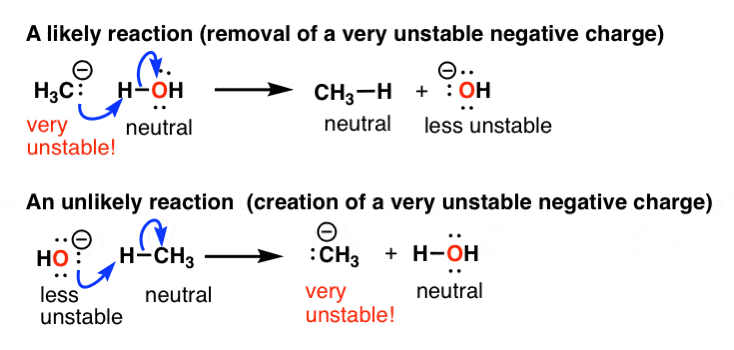
So what factors lead to the stabilization of negative charge? Two main things.
- negative charge is stabilized by adjacent positive charge (opposite charges attract!)
- negative charge tends to be less stable when it’s concentrated and more stable when it’s dispersed.
Think about that as you look at this list of seven factors that stabilize negative charge.
2. Factor #1: High Charge Densities Are Unstable
This one’s fairly straightforward to understand. High charge densities are unstable. So as we move from water to HO(–) to O(2-), we are getting progressively more unstable here. This is reflected in acidity tables; water (H2O) is far more likely to lose a proton to give HO(–) than HO(–) is likely to lose a proton to give O(2-)

3. Factor #2: As Electronegativity Increases Across The Periodic Table, So Does The Stability Of Negative Charge
Electronegativity is a rough measure how effectively the positively charged nucleus of an atom can “pull” electrons toward it. (Opposite charges attract.)
Electronegativity increases as we go across the periodic table. So if you compare the anions going from C , N, O to F across the periodic table, the stability of the negative charge will increase. This is also reflected in acidity values.
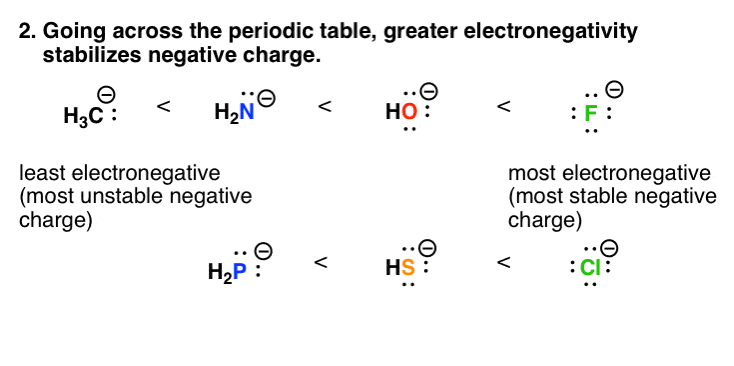
4. Factor #3: As Polarizability Increases Down The Periodic Table, So Does The Stability Of Negative Charge
Down the periodic table, it’s a little more helpful to think “dispersal of charge is good!” rather than “opposite charges attract”. Compare fluorine and iodine. The size of the fluorine ion (radius: 119 pm) is much smaller than iodine (radius: 206 pm). However, they both have a charge of negative 1.
Imagine two balls, each weighing one pound. But one is made of iron, and the other is made of rubber. Which ball is going to be smaller? The iron ball (smaller and harder – more dense) is like fluorine, and the rubber ball (larger and squishier) is like iodine. And a certain “squishiness” helps to stabilize charge, since it isn’t as concentrated over a small volume. That’s a way of expressing the greater polarizability of iodine.
Low charge densities are more stable!
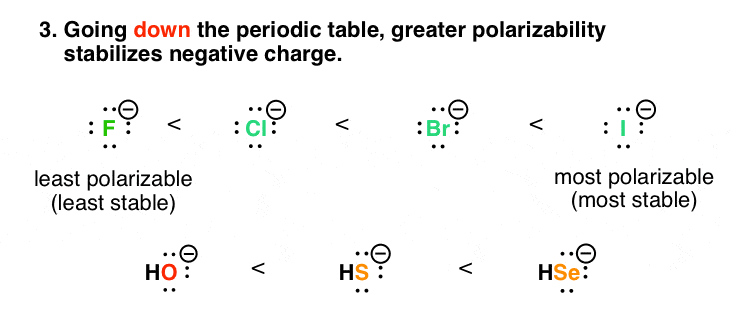
5. Factor #4: Resonance Stabilization Of Negative Charge
Along the same lines, a negative charge that is adjacent to one or more pi (π) bonds can disperse its negative charge over multiple atoms. We describe this phenomenon as “resonance“.
So in the example below, the negatively charged alkane on the left is much less stable than the adjacent negatively charged species, where the negative charge can be dispersed over multiple carbons through resonance. This is another example of how reducing charge density (or spreading it out) is a stabilizing influence.
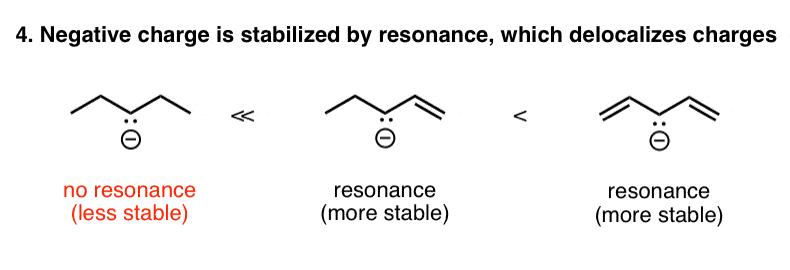
6. Factor #5: Electron-Withdrawing Groups (Inductive Effects) Stabilize Negative Charge
This one falls more into the auspices of “opposite charges attract”. A negative charge that is adjacent to an atom with electron withdrawing groups on it will be much more stable than an equivalent atom that is not. In the extreme case of CCl3(-), the resulting ion is many orders of magnitude more stable than H3C(-) itself. (This is the basis of the haloform reaction, by the way – see post).
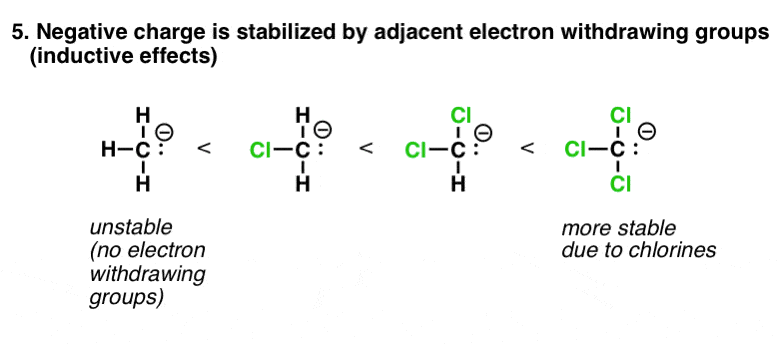
7. Increasing s-Character In The Hybridization Of An Atom Is Equivalent To Increasing Its Electronegativity
s orbitals are closer to the nucleus than p orbitals are. So electrons that are in s orbitals will be closer to the nucleus than electrons in p orbitals – and therefore, lower in energy (“opposite charges attract”). For this reason, electrons that are in sp orbitals are lower energy than sp2, which is lower energy than sp3, since they have greater s character (33% for sp2) than sp3 (25%). This makes the anions more stable, just as if it were on a more electronegative atom.
This is why terminal alkynes (pKa = 25) are much more acidic than alkenes and alkanes (pKa = 50)
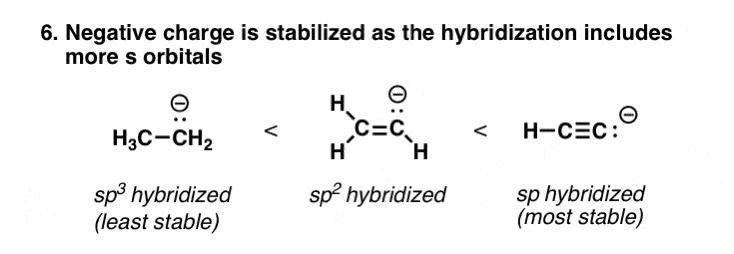
8. A Special Case: Aromaticity
This is a special case, covered in detail in organic chemistry 2 (peek ahead). Certain molecules possess a special stability – called aromaticity – that is enormously stabilizing, kind of like qualifying for a huge tax break from the government.
Certain negatively charged molecules – such as the cyclopentadienyl anion, pictured below – are aromatic, and therefore possess much greater stability than they would have otherwise.
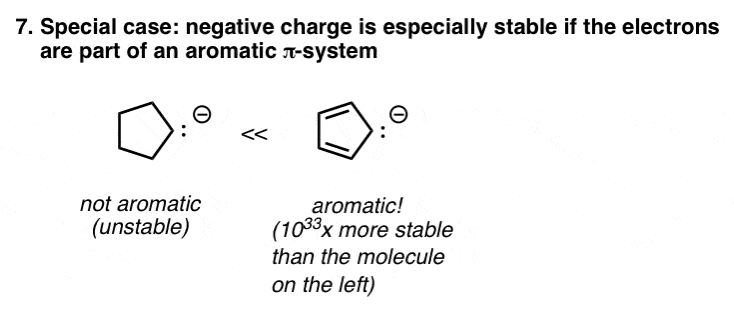
9. “Basicity” Is Just Another Word For “Stability Of The Negative Charge”
Seven factors?!!! So how do we know which is most important?
That’s a great question! These trends can interact with each other in unpredictable ways, and it’s hard to judge which is most important.
Thankfully, there’s a concept you’ve probably already met for figuring out the stability of these species, which can be readily measured. It’s called basicity. These factors determine how stable a base will be!
The basicity of a species tells you about how stable its lone pair of electrons are.
How do we find a good measure of basicity? Simple. It’s in the pKa table, a collection of measurements that’s been compared to the table of hand strengths in poker.
Bottom line:
- Two factors to watch out for: opposite charges attract, and dispersal of charge.
- unstable anions will tend to be at the intial tails of arrows (form bonds).
- stable anions will tend to be at the final heads of arrows (likely to be leaving groups)
Notes
00 General Chemistry Review
01 Bonding, Structure, and Resonance
- How Do We Know Methane (CH4) Is Tetrahedral?
- Hybrid Orbitals and Hybridization
- How To Determine Hybridization: A Shortcut
- Orbital Hybridization And Bond Strengths
- Sigma bonds come in six varieties: Pi bonds come in one
- Dipole Moments and Dipoles
- A Key Skill: How to Calculate Formal Charge
- The Four Intermolecular Forces and How They Affect Boiling Points
- 3 Trends That Affect Boiling Points
- How To Use Electronegativity To Determine Electron Density (and why NOT to trust formal charge)
- Introduction to Resonance
- How To Use Curved Arrows To Interchange Resonance Forms
- Evaluating Resonance Forms (1) - The Rule of Least Charges
- How To Find The Best Resonance Structure By Applying Electronegativity
- Evaluating Resonance Structures With Negative Charges
- Evaluating Resonance Structures With Positive Charge
- Exploring Resonance: Pi-Donation
- Exploring Resonance: Pi-acceptors
- In Summary: Evaluating Resonance Structures
- Drawing Resonance Structures: 3 Common Mistakes To Avoid
- How to apply electronegativity and resonance to understand reactivity
- Bond Hybridization Practice
- Structure and Bonding Practice Quizzes
- Resonance Structures Practice
02 Acid Base Reactions
- Introduction to Acid-Base Reactions
- Acid Base Reactions In Organic Chemistry
- The Stronger The Acid, The Weaker The Conjugate Base
- Walkthrough of Acid-Base Reactions (3) - Acidity Trends
- Five Key Factors That Influence Acidity
- Acid-Base Reactions: Introducing Ka and pKa
- How to Use a pKa Table
- The pKa Table Is Your Friend
- A Handy Rule of Thumb for Acid-Base Reactions
- Acid Base Reactions Are Fast
- pKa Values Span 60 Orders Of Magnitude
- How Protonation and Deprotonation Affect Reactivity
- Acid Base Practice Problems
03 Alkanes and Nomenclature
- Meet the (Most Important) Functional Groups
- Condensed Formulas: Deciphering What the Brackets Mean
- Hidden Hydrogens, Hidden Lone Pairs, Hidden Counterions
- Don't Be Futyl, Learn The Butyls
- Primary, Secondary, Tertiary, Quaternary In Organic Chemistry
- Branching, and Its Affect On Melting and Boiling Points
- The Many, Many Ways of Drawing Butane
- Wedge And Dash Convention For Tetrahedral Carbon
- Common Mistakes in Organic Chemistry: Pentavalent Carbon
- Table of Functional Group Priorities for Nomenclature
- Summary Sheet - Alkane Nomenclature
- Organic Chemistry IUPAC Nomenclature Demystified With A Simple Puzzle Piece Approach
- Boiling Point Quizzes
- Organic Chemistry Nomenclature Quizzes
04 Conformations and Cycloalkanes
- Staggered vs Eclipsed Conformations of Ethane
- Conformational Isomers of Propane
- Newman Projection of Butane (and Gauche Conformation)
- Introduction to Cycloalkanes
- Geometric Isomers In Small Rings: Cis And Trans Cycloalkanes
- Calculation of Ring Strain In Cycloalkanes
- Cycloalkanes - Ring Strain In Cyclopropane And Cyclobutane
- Cyclohexane Conformations
- Cyclohexane Chair Conformation: An Aerial Tour
- How To Draw The Cyclohexane Chair Conformation
- The Cyclohexane Chair Flip
- The Cyclohexane Chair Flip - Energy Diagram
- Substituted Cyclohexanes - Axial vs Equatorial
- Ranking The Bulkiness Of Substituents On Cyclohexanes: "A-Values"
- Cyclohexane Chair Conformation Stability: Which One Is Lower Energy?
- Fused Rings - Cis-Decalin and Trans-Decalin
- Naming Bicyclic Compounds - Fused, Bridged, and Spiro
- Bredt's Rule (And Summary of Cycloalkanes)
- Newman Projection Practice
- Cycloalkanes Practice Problems
05 A Primer On Organic Reactions
- The Most Important Question To Ask When Learning a New Reaction
- Curved Arrows (for reactions)
- Nucleophiles and Electrophiles
- The Three Classes of Nucleophiles
- Nucleophilicity vs. Basicity
- What Makes A Good Nucleophile?
- What Makes A Good Leaving Group?
- 3 Factors That Stabilize Carbocations
- Equilibrium and Energy Relationships
- 7 Factors that stabilize negative charge in organic chemistry
- 7 Factors That Stabilize Positive Charge in Organic Chemistry
- What's a Transition State?
- Hammond's Postulate
- Learning Organic Chemistry Reactions: A Checklist (PDF)
06 Free Radical Reactions
- Free Radical Reactions
- 3 Factors That Stabilize Free Radicals
- Bond Strengths And Radical Stability
- Free Radical Initiation: Why Is "Light" Or "Heat" Required?
- Initiation, Propagation, Termination
- Monochlorination Products Of Propane, Pentane, And Other Alkanes
- Selectivity In Free Radical Reactions
- Selectivity in Free Radical Reactions: Bromination vs. Chlorination
- Halogenation At Tiffany's
- Allylic Bromination
- Bonus Topic: Allylic Rearrangements
- In Summary: Free Radicals
- Synthesis (2) - Reactions of Alkanes
- Free Radicals Practice Quizzes
07 Stereochemistry and Chirality
- Types of Isomers: Constitutional Isomers, Stereoisomers, Enantiomers, and Diastereomers
- How To Draw The Enantiomer Of A Chiral Molecule
- How To Draw A Bond Rotation
- Introduction to Assigning (R) and (S): The Cahn-Ingold-Prelog Rules
- Assigning Cahn-Ingold-Prelog (CIP) Priorities (2) - The Method of Dots
- Enantiomers vs Diastereomers vs The Same? Two Methods For Solving Problems
- Assigning R/S To Newman Projections (And Converting Newman To Line Diagrams)
- How To Determine R and S Configurations On A Fischer Projection
- The Meso Trap
- Optical Rotation, Optical Activity, and Specific Rotation
- Optical Purity and Enantiomeric Excess
- What's a Racemic Mixture?
- Chiral Allenes And Chiral Axes
- Stereochemistry Practice Problems and Quizzes
08 Substitution Reactions
- Nucleophilic Substitution Reactions - Introduction
- Two Types of Nucleophilic Substitution Reactions
- The SN2 Mechanism
- Why the SN2 Reaction Is Powerful
- The SN1 Mechanism
- The Conjugate Acid Is A Better Leaving Group
- Comparing the SN1 and SN2 Reactions
- Polar Protic? Polar Aprotic? Nonpolar? All About Solvents
- Steric Hindrance is Like a Fat Goalie
- Common Blind Spot: Intramolecular Reactions
- Substitution Practice - SN1
- Substitution Practice - SN2
09 Elimination Reactions
- Elimination Reactions (1): Introduction And The Key Pattern
- Elimination Reactions (2): The Zaitsev Rule
- Elimination Reactions Are Favored By Heat
- Two Elimination Reaction Patterns
- The E1 Reaction
- The E2 Mechanism
- E1 vs E2: Comparing the E1 and E2 Reactions
- Antiperiplanar Relationships: The E2 Reaction and Cyclohexane Rings
- Bulky Bases in Elimination Reactions
- Comparing the E1 vs SN1 Reactions
- Elimination (E1) Reactions With Rearrangements
- E1cB - Elimination (Unimolecular) Conjugate Base
- Elimination (E1) Practice Problems And Solutions
- Elimination (E2) Practice Problems and Solutions
10 Rearrangements
11 SN1/SN2/E1/E2 Decision
- Identifying Where Substitution and Elimination Reactions Happen
- Deciding SN1/SN2/E1/E2 (1) - The Substrate
- Deciding SN1/SN2/E1/E2 (2) - The Nucleophile/Base
- SN1 vs E1 and SN2 vs E2 : The Temperature
- Deciding SN1/SN2/E1/E2 - The Solvent
- Wrapup: The Key Factors For Determining SN1/SN2/E1/E2
- Alkyl Halide Reaction Map And Summary
- SN1 SN2 E1 E2 Practice Problems
12 Alkene Reactions
- E and Z Notation For Alkenes (+ Cis/Trans)
- Alkene Stability
- Alkene Addition Reactions: "Regioselectivity" and "Stereoselectivity" (Syn/Anti)
- Stereoselective and Stereospecific Reactions
- Hydrohalogenation of Alkenes and Markovnikov's Rule
- Hydration of Alkenes With Aqueous Acid
- Rearrangements in Alkene Addition Reactions
- Halogenation of Alkenes and Halohydrin Formation
- Oxymercuration Demercuration of Alkenes
- Hydroboration Oxidation of Alkenes
- m-CPBA (meta-chloroperoxybenzoic acid)
- OsO4 (Osmium Tetroxide) for Dihydroxylation of Alkenes
- Palladium on Carbon (Pd/C) for Catalytic Hydrogenation of Alkenes
- Cyclopropanation of Alkenes
- A Fourth Alkene Addition Pattern - Free Radical Addition
- Alkene Reactions: Ozonolysis
- Oxidative Cleavage of Vicinal Diols With NaIO4 and Pb(OAc)4
- Summary: Three Key Families Of Alkene Reaction Mechanisms
- Synthesis (4) - Alkene Reaction Map, Including Alkyl Halide Reactions
- Alkene Reactions Practice Problems
13 Alkyne Reactions
- Acetylides from Alkynes, And Substitution Reactions of Acetylides
- Partial Reduction of Alkynes With Lindlar's Catalyst
- Partial Reduction of Alkynes With Na/NH3 To Obtain Trans Alkenes
- Alkyne Hydroboration With "R2BH"
- Hydration and Oxymercuration of Alkynes
- Hydrohalogenation of Alkynes
- Alkyne Halogenation: Bromination and Chlorination of Alkynes
- Oxidation of Alkynes With O3 and KMnO4
- Alkenes To Alkynes Via Halogenation And Elimination Reactions
- Alkynes Are A Blank Canvas
- Synthesis (5) - Reactions of Alkynes
- Alkyne Reactions Practice Problems With Answers
14 Alcohols, Epoxides and Ethers
- Alcohols - Nomenclature and Properties
- Alcohols Can Act As Acids Or Bases (And Why It Matters)
- Alcohols - Acidity and Basicity
- The Williamson Ether Synthesis
- Ethers From Alkenes, Tertiary Alkyl Halides and Alkoxymercuration
- Alcohols To Ethers via Acid Catalysis
- Cleavage Of Ethers With Acid
- Epoxides - The Outlier Of The Ether Family
- Opening of Epoxides With Acid
- Epoxide Ring Opening With Base
- Making Alkyl Halides From Alcohols
- Tosylates And Mesylates
- PBr3 and SOCl2
- Elimination Reactions of Alcohols
- Elimination of Alcohols To Alkenes With POCl3
- Alcohol Oxidation: "Strong" and "Weak" Oxidants
- Demystifying The Mechanisms of Alcohol Oxidations
- Protecting Groups For Alcohols
- Thiols And Thioethers
- Calculating the oxidation state of a carbon
- Oxidation and Reduction in Organic Chemistry
- Oxidation Ladders
- SOCl2 Mechanism For Alcohols To Alkyl Halides: SN2 versus SNi
- Alcohol Reactions Roadmap (PDF)
- Alcohol Reaction Practice Problems
- Epoxide Reaction Quizzes
- Oxidation and Reduction Practice Quizzes
15 Organometallics
- What's An Organometallic?
- Formation of Grignard and Organolithium Reagents
- Organometallics Are Strong Bases
- Reactions of Grignard Reagents
- Protecting Groups In Grignard Reactions
- Synthesis Problems Involving Grignard Reagents
- Grignard Reactions And Synthesis (2)
- Organocuprates (Gilman Reagents): How They're Made
- Gilman Reagents (Organocuprates): What They're Used For
- The Heck, Suzuki, and Olefin Metathesis Reactions (And Why They Don't Belong In Most Introductory Organic Chemistry Courses)
- Reaction Map: Reactions of Organometallics
- Grignard Practice Problems
16 Spectroscopy
- Degrees of Unsaturation (or IHD, Index of Hydrogen Deficiency)
- Conjugation And Color (+ How Bleach Works)
- Introduction To UV-Vis Spectroscopy
- UV-Vis Spectroscopy: Absorbance of Carbonyls
- UV-Vis Spectroscopy: Practice Questions
- Bond Vibrations, Infrared Spectroscopy, and the "Ball and Spring" Model
- Infrared (IR) Spectroscopy: A Quick Primer On Interpreting Spectra
- IR Spectroscopy: 4 Practice Problems
- 1H NMR: How Many Signals?
- Homotopic, Enantiotopic, Diastereotopic
- Diastereotopic Protons in 1H NMR Spectroscopy: Examples
- 13-C NMR - How Many Signals
- Liquid Gold: Pheromones In Doe Urine
- Natural Product Isolation (1) - Extraction
- Natural Product Isolation (2) - Purification Techniques, An Overview
- Structure Determination Case Study: Deer Tarsal Gland Pheromone
17 Dienes and MO Theory
- What To Expect In Organic Chemistry 2
- Are these molecules conjugated?
- Conjugation And Resonance In Organic Chemistry
- Bonding And Antibonding Pi Orbitals
- Molecular Orbitals of The Allyl Cation, Allyl Radical, and Allyl Anion
- Pi Molecular Orbitals of Butadiene
- Reactions of Dienes: 1,2 and 1,4 Addition
- Thermodynamic and Kinetic Products
- More On 1,2 and 1,4 Additions To Dienes
- s-cis and s-trans
- The Diels-Alder Reaction
- Cyclic Dienes and Dienophiles in the Diels-Alder Reaction
- Stereochemistry of the Diels-Alder Reaction
- Exo vs Endo Products In The Diels Alder: How To Tell Them Apart
- HOMO and LUMO In the Diels Alder Reaction
- Why Are Endo vs Exo Products Favored in the Diels-Alder Reaction?
- Diels-Alder Reaction: Kinetic and Thermodynamic Control
- The Retro Diels-Alder Reaction
- The Intramolecular Diels Alder Reaction
- Regiochemistry In The Diels-Alder Reaction
- The Cope and Claisen Rearrangements
- Electrocyclic Reactions
- Electrocyclic Ring Opening And Closure (2) - Six (or Eight) Pi Electrons
- Diels Alder Practice Problems
- Molecular Orbital Theory Practice
18 Aromaticity
- Introduction To Aromaticity
- Rules For Aromaticity
- Huckel's Rule: What Does 4n+2 Mean?
- Aromatic, Non-Aromatic, or Antiaromatic? Some Practice Problems
- Antiaromatic Compounds and Antiaromaticity
- The Pi Molecular Orbitals of Benzene
- The Pi Molecular Orbitals of Cyclobutadiene
- Frost Circles
- Aromaticity Practice Quizzes
19 Reactions of Aromatic Molecules
- Electrophilic Aromatic Substitution: Introduction
- Activating and Deactivating Groups In Electrophilic Aromatic Substitution
- Electrophilic Aromatic Substitution - The Mechanism
- Ortho-, Para- and Meta- Directors in Electrophilic Aromatic Substitution
- Understanding Ortho, Para, and Meta Directors
- Why are halogens ortho- para- directors?
- Disubstituted Benzenes: The Strongest Electron-Donor "Wins"
- Electrophilic Aromatic Substitutions (1) - Halogenation of Benzene
- Electrophilic Aromatic Substitutions (2) - Nitration and Sulfonation
- EAS Reactions (3) - Friedel-Crafts Acylation and Friedel-Crafts Alkylation
- Intramolecular Friedel-Crafts Reactions
- Nucleophilic Aromatic Substitution (NAS)
- Nucleophilic Aromatic Substitution (2) - The Benzyne Mechanism
- Reactions on the "Benzylic" Carbon: Bromination And Oxidation
- The Wolff-Kishner, Clemmensen, And Other Carbonyl Reductions
- More Reactions on the Aromatic Sidechain: Reduction of Nitro Groups and the Baeyer Villiger
- Aromatic Synthesis (1) - "Order Of Operations"
- Synthesis of Benzene Derivatives (2) - Polarity Reversal
- Aromatic Synthesis (3) - Sulfonyl Blocking Groups
- Birch Reduction
- Synthesis (7): Reaction Map of Benzene and Related Aromatic Compounds
- Aromatic Reactions and Synthesis Practice
- Electrophilic Aromatic Substitution Practice Problems
20 Aldehydes and Ketones
- What's The Alpha Carbon In Carbonyl Compounds?
- Nucleophilic Addition To Carbonyls
- Aldehydes and Ketones: 14 Reactions With The Same Mechanism
- Sodium Borohydride (NaBH4) Reduction of Aldehydes and Ketones
- Grignard Reagents For Addition To Aldehydes and Ketones
- Wittig Reaction
- Hydrates, Hemiacetals, and Acetals
- Imines - Properties, Formation, Reactions, and Mechanisms
- All About Enamines
- Breaking Down Carbonyl Reaction Mechanisms: Reactions of Anionic Nucleophiles (Part 2)
- Aldehydes Ketones Reaction Practice
21 Carboxylic Acid Derivatives
- Nucleophilic Acyl Substitution (With Negatively Charged Nucleophiles)
- Addition-Elimination Mechanisms With Neutral Nucleophiles (Including Acid Catalysis)
- Basic Hydrolysis of Esters - Saponification
- Transesterification
- Proton Transfer
- Fischer Esterification - Carboxylic Acid to Ester Under Acidic Conditions
- Lithium Aluminum Hydride (LiAlH4) For Reduction of Carboxylic Acid Derivatives
- LiAlH[Ot-Bu]3 For The Reduction of Acid Halides To Aldehydes
- Di-isobutyl Aluminum Hydride (DIBAL) For The Partial Reduction of Esters and Nitriles
- Amide Hydrolysis
- Thionyl Chloride (SOCl2) And Conversion of Carboxylic Acids to Acid Halides
- Diazomethane (CH2N2)
- Carbonyl Chemistry: Learn Six Mechanisms For the Price Of One
- Making Music With Mechanisms (PADPED)
- Carboxylic Acid Derivatives Practice Questions
22 Enols and Enolates
- Keto-Enol Tautomerism
- Enolates - Formation, Stability, and Simple Reactions
- Kinetic Versus Thermodynamic Enolates
- Aldol Addition and Condensation Reactions
- Reactions of Enols - Acid-Catalyzed Aldol, Halogenation, and Mannich Reactions
- Claisen Condensation and Dieckmann Condensation
- Decarboxylation
- The Malonic Ester and Acetoacetic Ester Synthesis
- The Michael Addition Reaction and Conjugate Addition
- The Robinson Annulation
- Haloform Reaction
- The Hell–Volhard–Zelinsky Reaction
- Enols and Enolates Practice Quizzes
23 Amines
- The Amide Functional Group: Properties, Synthesis, and Nomenclature
- Basicity of Amines And pKaH
- 5 Key Basicity Trends of Amines
- The Mesomeric Effect And Aromatic Amines
- Nucleophilicity of Amines
- Alkylation of Amines (Sucks!)
- Reductive Amination
- The Gabriel Synthesis
- Some Reactions of Azides
- The Hofmann Elimination
- The Hofmann and Curtius Rearrangements
- The Cope Elimination
- Protecting Groups for Amines - Carbamates
- The Strecker Synthesis of Amino Acids
- Introduction to Peptide Synthesis
- Reactions of Diazonium Salts: Sandmeyer and Related Reactions
- Amine Practice Questions
24 Carbohydrates
- D and L Notation For Sugars
- Pyranoses and Furanoses: Ring-Chain Tautomerism In Sugars
- What is Mutarotation?
- Reducing Sugars
- The Big Damn Post Of Carbohydrate-Related Chemistry Definitions
- The Haworth Projection
- Converting a Fischer Projection To A Haworth (And Vice Versa)
- Reactions of Sugars: Glycosylation and Protection
- The Ruff Degradation and Kiliani-Fischer Synthesis
- Isoelectric Points of Amino Acids (and How To Calculate Them)
- Carbohydrates Practice
- Amino Acid Quizzes
25 Fun and Miscellaneous
- A Gallery of Some Interesting Molecules From Nature
- Screw Organic Chemistry, I'm Just Going To Write About Cats
- On Cats, Part 1: Conformations and Configurations
- On Cats, Part 2: Cat Line Diagrams
- On Cats, Part 4: Enantiocats
- On Cats, Part 6: Stereocenters
- Organic Chemistry Is Shit
- The Organic Chemistry Behind "The Pill"
- Maybe they should call them, "Formal Wins" ?
- Why Do Organic Chemists Use Kilocalories?
- The Principle of Least Effort
- Organic Chemistry GIFS - Resonance Forms
- Reproducibility In Organic Chemistry
- What Holds The Nucleus Together?
- How Reactions Are Like Music
- Organic Chemistry and the New MCAT
26 Organic Chemistry Tips and Tricks
- Common Mistakes: Formal Charges Can Mislead
- Partial Charges Give Clues About Electron Flow
- Draw The Ugly Version First
- Organic Chemistry Study Tips: Learn the Trends
- The 8 Types of Arrows In Organic Chemistry, Explained
- Top 10 Skills To Master Before An Organic Chemistry 2 Final
- Common Mistakes with Carbonyls: Carboxylic Acids... Are Acids!
- Planning Organic Synthesis With "Reaction Maps"
- Alkene Addition Pattern #1: The "Carbocation Pathway"
- Alkene Addition Pattern #2: The "Three-Membered Ring" Pathway
- Alkene Addition Pattern #3: The "Concerted" Pathway
- Number Your Carbons!
- The 4 Major Classes of Reactions in Org 1
- How (and why) electrons flow
- Grossman's Rule
- Three Exam Tips
- A 3-Step Method For Thinking Through Synthesis Problems
- Putting It Together
- Putting Diels-Alder Products in Perspective
- The Ups and Downs of Cyclohexanes
- The Most Annoying Exceptions in Org 1 (Part 1)
- The Most Annoying Exceptions in Org 1 (Part 2)
- The Marriage May Be Bad, But the Divorce Still Costs Money
- 9 Nomenclature Conventions To Know
- Nucleophile attacks Electrophile
27 Case Studies of Successful O-Chem Students
- Success Stories: How Corina Got The The "Hard" Professor - And Got An A+ Anyway
- How Helena Aced Organic Chemistry
- From a "Drop" To B+ in Org 2 – How A Hard Working Student Turned It Around
- How Serge Aced Organic Chemistry
- Success Stories: How Zach Aced Organic Chemistry 1
- Success Stories: How Kari Went From C– to B+
- How Esther Bounced Back From a "C" To Get A's In Organic Chemistry 1 And 2
- How Tyrell Got The Highest Grade In Her Organic Chemistry Course
- This Is Why Students Use Flashcards
- Success Stories: How Stu Aced Organic Chemistry
- How John Pulled Up His Organic Chemistry Exam Grades
- Success Stories: How Nathan Aced Organic Chemistry (Without It Taking Over His Life)
- How Chris Aced Org 1 and Org 2
- Interview: How Jay Got an A+ In Organic Chemistry
- How to Do Well in Organic Chemistry: One Student's Advice
- "America's Top TA" Shares His Secrets For Teaching O-Chem
- "Organic Chemistry Is Like..." - A Few Metaphors
- How To Do Well In Organic Chemistry: Advice From A Tutor
- Guest post: "I went from being afraid of tests to actually looking forward to them".
this was really helpful thank you!
Thanks for the classification,but will anion on ethyne be more stable than a benzylic anion?
(I mean where cases cross each other electronegativity vs resonance.
Resonance is taking place in carbons with sp2 configuration(in case of benzylic anion),
so which would me more stable?
The pKa of toluene is about 42. The pKa of ethyne is about 25. So the anion on the conjugate base of ethyne is much more stable than the anion in the conjugate base of toluene.
More dispersal of charge means what?
It means it’s less concentrated; it’s spread out over a greater volume.
Triphenyl methyl carbanion and diphenyl methyl carbanion which is stable why
According to the Evans Pka Table, http://evans.rc.fas.harvard.edu/pdf/evans_pKa_table.pdf , the pKa of triphenylmethane is 31 and the pKa of diphenylmethane is 33. So there’s about a 100 fold increase in stability for the triphenylmethane conjugate base. Why do you think that is?
Hello James,
I wanted to thank you for this awesome project of yours here, I really wish lecturers would pay more attention to intuition and proper teaching as you do here instead of just showing mechanisms.
I am struggling to understand a couple of concepts here and would love to hear what you think about them:
1. You wrote that high charge densities are unstable and followed it up by writing that electronegative atoms are more stable, which appears to me as contradictory. Isn’t a more electronegative atom/ion necessarily creates a high charge density area due its strong electron attraction?
2. Following your reasoning sp orbitals are more stable than sp2 than sp3, as they have more s character and are therefore closer to the nucleus and lower in energy, but we also get more pi bonds (that are higher in energy) for fewer hybridizations in such molecules, while in more hybridized molecules these pi bonds will have at least some s character that will lower their energy. Aren’t these reasonings contradictory as well?
Thanks for your time!
1. “High charge densities are unstable” is a good rule of thumb, although it’s not easy to look at this quantitatively because some of the variables are different. It’s more of an intuitive principle. For example, compare the stabilities of H2O vs HO(-) vs O(2-) , or NH3 vs NH2(-) vs NH(2-) vs N(3-).
Given that, if one is going to have a negative charge, negative charge will be stabilized *more* by a more electronegative element. This trend is most evident going across the periodic table – for example F(-) versus HO(-) versus NH2(-) versus CH3(-). Fluorine is the most electronegative element in this series and F(-) is also the most stable; carbon is the least electronegative element and CH3(-) is the least stable.
Going down the periodic table it is not as straightforward because valence electrons are held in orbitals more distant from the nucleus and polarizability is more important.
2. Pi bonds don’t have any s character. Pi bonds are made solely from the overlap of p orbitals. Just to make sure this is clear, in a molecule like ethene where the two carbons are attached by a double bond, only one of those bonds is a pi bond – the other one is a sigma bond between the two sp2 hybridized carbons.
Sorry, I meant sp(n) hybridized orbital (instead of pi), say CN- vs. CH3-, CN- has a low energy sp orbital and two high energy p orbitals vs. CH3- that has three hybridized orbitals that are between the two (energy wise).
The charge is localized in the sp(n) orbitals so the p orbitals in CN(-) are irrelevant to the stability.
One way of looking at it is that an sp orbital has a higher effective electronegativity than an sp2, which has high effective electronegativity than an sp3 orbital. The negative charge is held more tightly to the nucleus.
Thank you, I think I am starting to get it. This is analogous to electronegativity since in both cases (higher sp character / electronegativity) the bond is pulled closer towards the nucleus.
Would it be right to say that the delocalization of the p orbitals between both atoms in CN(-) also plays a part in stabilizing the negative charge?
Edit: Noticed that the lone pair on the carbon is localized so it can’t be stabilized through delocalization so never mind that last question :).
Thanks again.
Hi,
Please help with options. School project – to charge perspex negatively to extract polystyrene from sand. We used perspex sheet and rubbed it with wool roller to load perspex negatively, but the charge fluctuates and is not lifting polystyrene constantly. Suggestions as to how to increase to negative charge to be stronger?
which has periority in determining stability of carbanion :resonance or orbitals
This might be a stupid question but i’m a little confused as to why fluorine is the most electronegative and most stable in figure 2, but in figure 3 fluorine is the least polarizable and least stable? How would you know when to consider it electronegative or polarizable?
It would be difficult to know from first principles whether or not electronegativity or polarizability is most significant in determining the stability of anions. Measurement of acidities, however, has given us the ability to evaluate this on a universal scale (acidity). We can observe the empirical trend (electronegativity is most important as we go across a row of the periodic trend, polarizability is most important as we go down), but explaining exactly why this is is a deep and difficult question to answer.
So it just depends on the reaction? And one more question, does quantum mechanics have anything to do with it? Because if it does ill stop asking questions!
Thanks for putting this together! This website has been so helpful.
One correction: In 6. Orbitals, you state that sp2 has 50% s character. I believe that sp has 50%, but sp2 actually has 33.333%. If I’m wrong please let me know!
Thanks again for the time you’ve put into this thing!
Oh great – thanks for the correction!
is a resonance stabilized compound stabler than a double or triple bonded compound?
It’s not possible to answer this question without a more specific example.
like in the case of ethene and benzene and ethyne and benzene